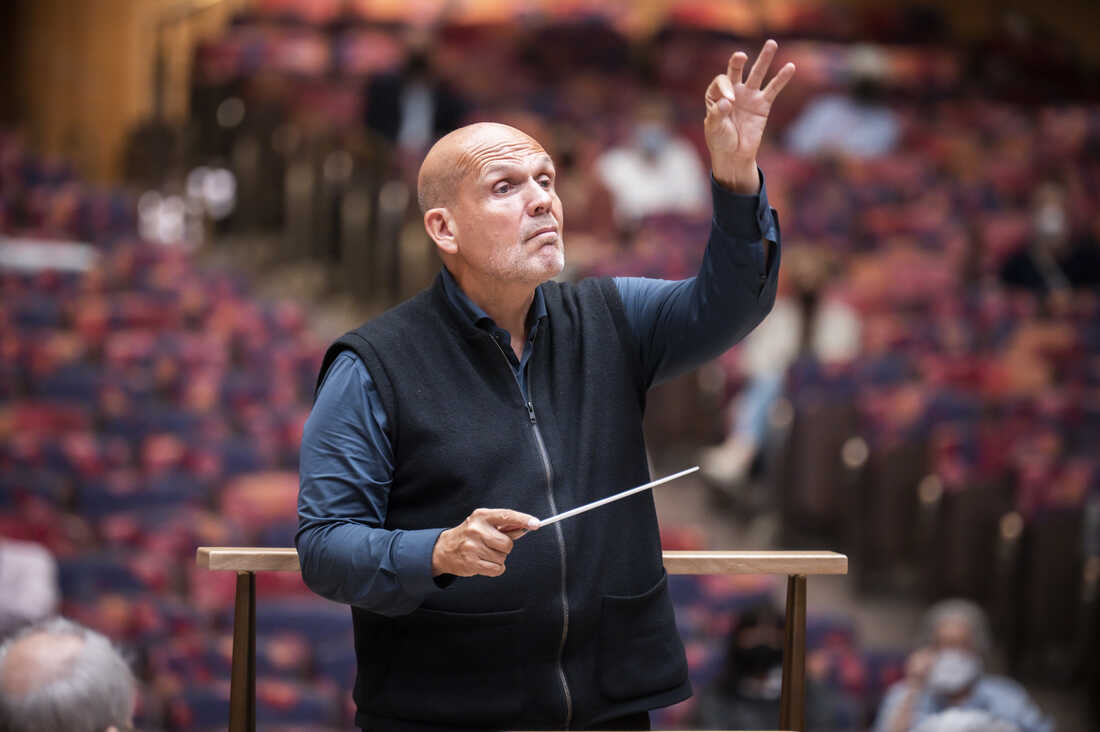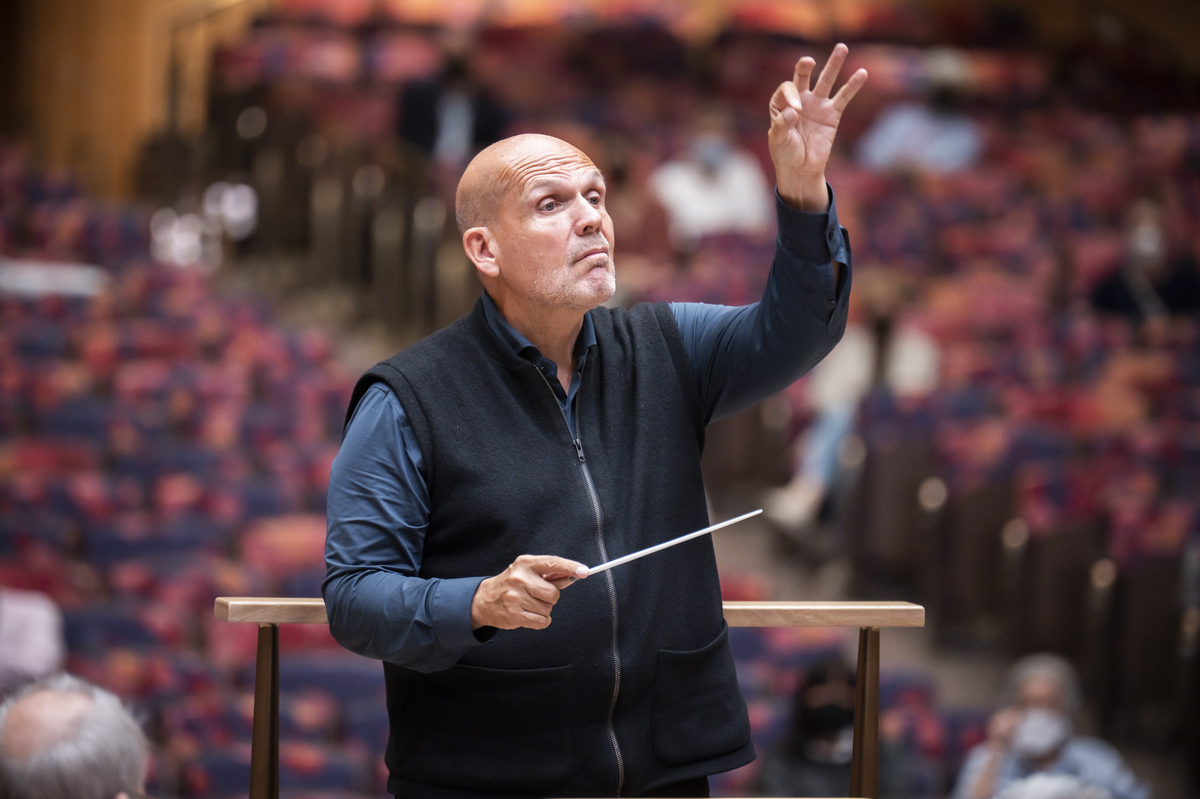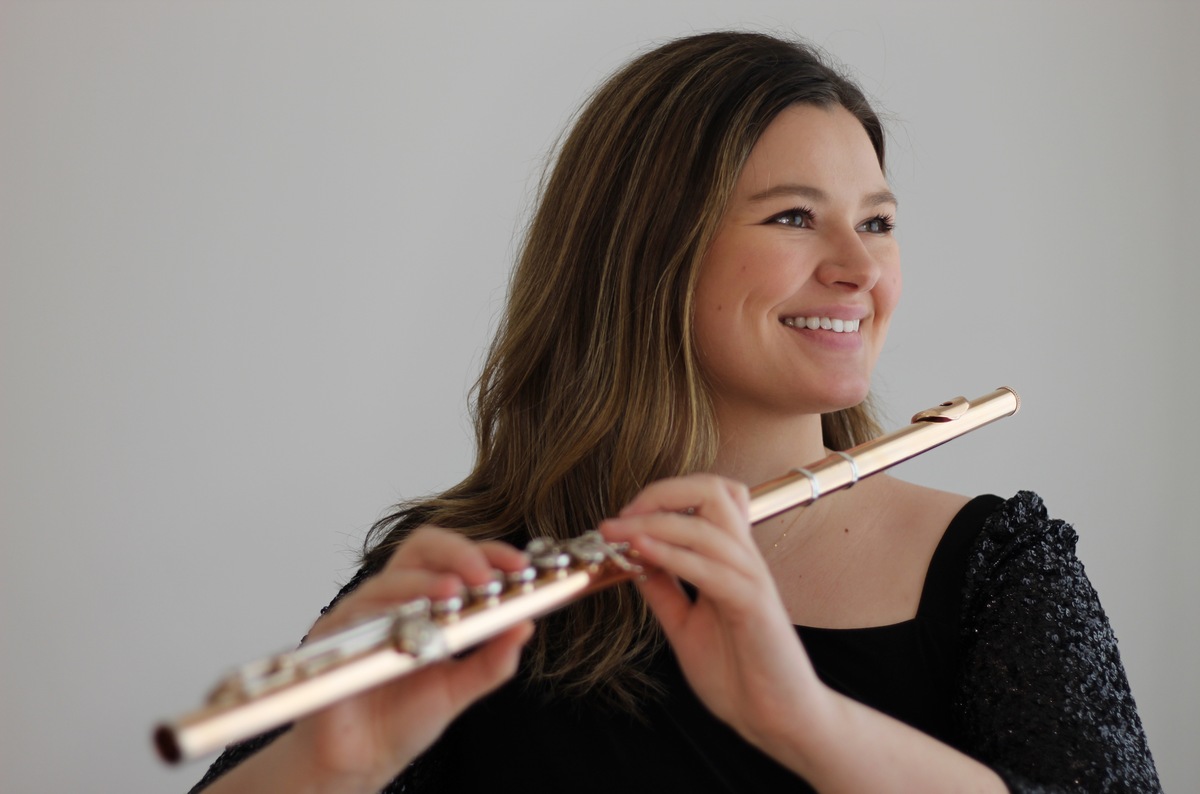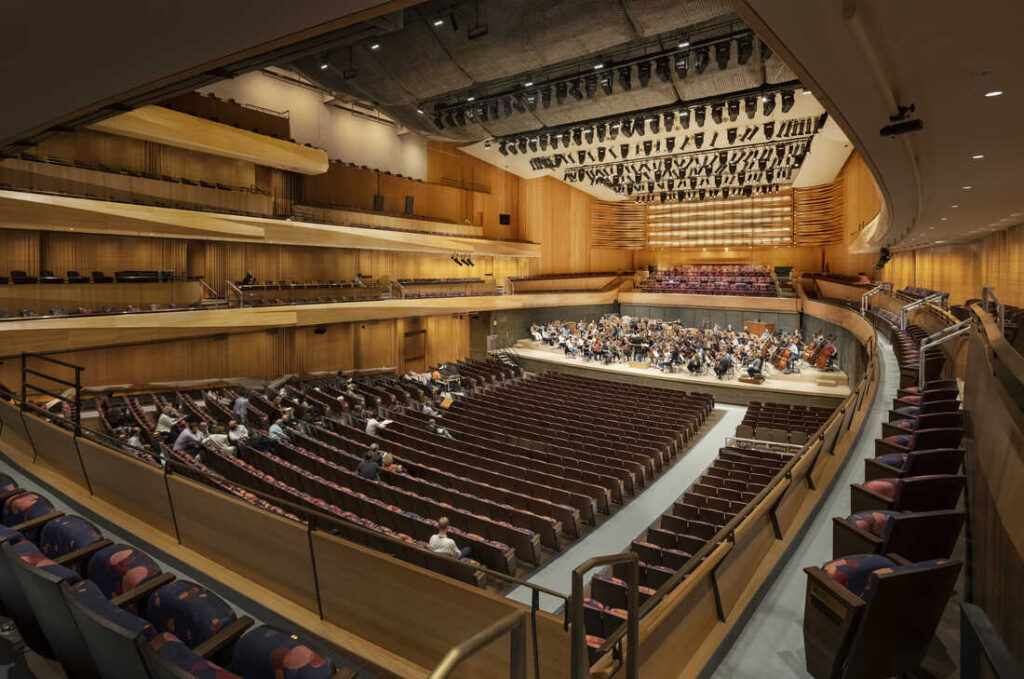The new interior of David Geffen Hall, during a New York Philharmonic tuning session.
Michael Moran/New York Philharmonic
hide caption
toggle caption
Michael Moran/New York Philharmonic

The new interior of David Geffen Hall, during a New York Philharmonic tuning session.
Michael Moran/New York Philharmonic
The new David Geffen Hall in Lincoln Center opens this week, and while the travertine marble exterior of the hall remains the same, everything inside has changed, said Deborah Borda, president and CEO of the New York Philharmonic.
“It’s not a renovation,” she said, “it’s a transformation. It’s an entirely new hall. We stripped to the bones.”
The New York Philharmonic left its home in the acoustically perfect Carnegie Hall for the Lincoln Center complex in 1962. But its new concert hall was … acoustically imperfect. And too large.
“The hall was originally designed acoustically for the envelope to be for 2,200 people,” said Borda. “When the hall opened, the boards of directors of both the Philharmonic and Lincoln Center decided they wanted to have it the same size as Carnegie Hall. So, they put in 2,800 seats when it was designed for 2,200 seats.”
And that turned out to be the hall’s Achilles’ heel. Over the decades, as the name changed from Philharmonic Hall to Avery Fisher Hall to David Geffen Hall, various renovations tried and failed to fix the inherent problems. In recent years, the Philharmonic and Lincoln Center finally agreed to do a gut rehab, making the space more intimate by reducing seating capacity to the original 2,200.
When the pandemic hit, those plans accelerated. The $600 million project employed over 6,000 people, many of whom came from minority- and women-owned businesses.
But the goal wasn’t just to make a beautiful concert hall, said Henry Timms, Lincoln Center’s president and CEO.
“I think the great hope with this project is that more people feel more welcome at Lincoln Center,” he said. “We have been so committed to the heights of performance, to that kind of ambition and that dedication, which makes the greatest art. We have not been as dedicated to how do we reach more people on their terms, not on ours. That’s an important shift.”
So, there are many outward facing aspects to the new Geffen Hall — people can watch concerts for free on both an enormous screen in the expanded lobby and outside a studio next to the street; there will be visual art on display; and some concerts will be pay-what-you-can.
The hall is like an instrument
But, of course, the centerpiece is the interior of the hall itself. In August and September, the Philharmonic played several “tune-up” sessions in the hall to get used to the new acoustics. Music director Jaap van Zweden said the orchestra immediately realized they didn’t need to push to be heard.

Jaap van Zweden leads the second acoustic rehearsal with New York Philharmonic at the newly renovated David Geffen Hall this past August.
Chris Lee/New York Philharmonic
hide caption
toggle caption
Chris Lee/New York Philharmonic

Jaap van Zweden leads the second acoustic rehearsal with New York Philharmonic at the newly renovated David Geffen Hall this past August.
Chris Lee/New York Philharmonic
“We need to be very careful that it is not too loud and that we don’t need to create too much our own acoustic anymore,” he says. “The hall gives us back. This is completely new for the orchestra.”
Concertmaster Frank Huang agreed. “In the old David Geffen, I feel like especially for the strings, we had to really make sure we were singing small notes,” he said. “Making sure they were ringing, that they had enough projection to get to the back of the hall.”
Now, he said, they need to learn how to play softly and trust that the hall will take care of the sound.
“There’s an analogy that I think explains it very well,” said the Philharmonic’s Borda, “which is the hall is like an instrument, and the New York Philharmonic is learning to play its new instrument.”
Paul Scarbrough, the lead acoustician, was on hand for the tuneup sessions to make any changes needed to improve the sound.
“We sat onstage as well as in the hall,” he said, “and then we would get feedback from Jaap and from the musicians that would help us to begin to make some subtle adjustments to the attitude of the various canopy panels over the stage, some tuning elements that are hidden in the doors on either side of the stage, and some other elements that are hidden around the stage. They’re available to us to kind of fine-tune the sound quality on the stage.”
Music director van Zweden said he was impressed with the tuning process. At one rehearsal, “they changed one panel and it changed completely the orchestra sound,” he marveled. “So that was an important moment.”
Scarbrough said that where the old Geffen Hall sometimes sounded muddy, the new hall offers much more clarity. “What we’re hearing is the timbres of the different instruments are very true, very pure,” he said. “A clarinet really sounds like a rich clarinet. The double basses have a wonderful warmth to them.”
The warmth of honey-colored wood — and psychology
There is a warmth to the new hall itself. The interior is made up of honey-colored wood — the side panels on the walls are milled to look like sound waves — and the seats are a colorful pattern that invokes blossom petals. “It’s meant to be a joyous space,” says Borda.

Deborah Borda, CEO of the New York Philharmonic
Dario Acosta/Lincoln Center
hide caption
toggle caption
Dario Acosta/Lincoln Center

Deborah Borda, CEO of the New York Philharmonic
Dario Acosta/Lincoln Center
But most important, the seats are 30% closer to the stage and they envelop the orchestra — there are even seats behind it, said principal architect Gary McCluskie.
“Performance is experienced by audience members in the round, in a surround, where we and the artists who are making the music are in one room together,” McCluskie said. “And that sense of connection between the audience and the musicians, I think is really important.”
McCluskie said the space was designed to create psycho-acoustics. “It’s got something to do with your mind and how you perceive sound being made,” he said. The warm wood colors and the intimacy “somehow architecturally helps set up the emotional experience of music.”
The stage itself is flexible. Twenty elevators allow sections to move up and down and create various risers for the orchestra. Now, the audience can see the brass and wind players in the back, as well as the string players in the front.

Alison Fierst, associate principal flute at the New York Philharmonic
Enze Yan
hide caption
toggle caption
Enze Yan

Alison Fierst, associate principal flute at the New York Philharmonic
Enze Yan
But also, it’s good for the musicians. “Practicality-wise, it’s nice to be able to see the conductor and not have to dodge other musicians’ heads in between,” said Alison Fierst, associate principal flute. “But also, acoustic-wise, it’s so much easier to hear, like, the principal row of players in the strings. Just to be able to see very clearly and lock in. It’s just so much easier. It’s a dream.”
For the Philharmonic’s Borda, seeing David Geffen Hall go from architectural renderings to a working venue is a dream fulfilled. “It’s more than I hoped for, honestly,” she said. “I think sometimes we dare to hope too much. We’ll let people come in and judge for themselves. But I’m pretty thrilled.”

